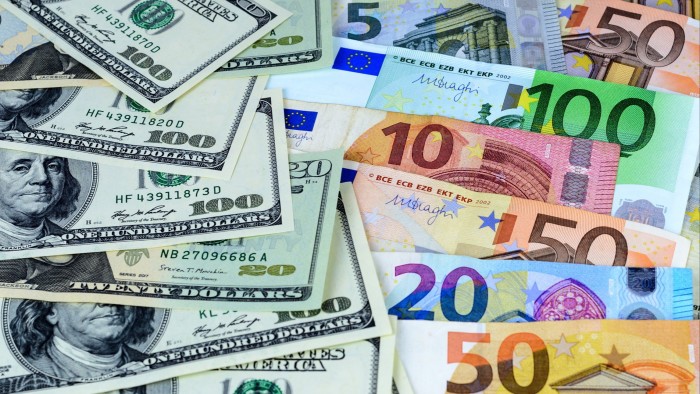Unlock the Editor’s Digest for free
Roula Khalaf, Editor of the FT, selects her favourite stories in this weekly newsletter.
The policy choices of the Trump administration have emphatically put the dominance of the dollar’s global reserve status in doubt. The big question is whether anything else is ready to take up the slack.
A few months ago, talk of the US torching its own haven status was the wild-eyed stuff of old-school gold bug Twitter accounts. (The gold bugs, it turns out, were on to something.) Now the topic has shifted from taboo to perfectly reasonable, and the evidence to support it just keeps on cropping up — the latest being the downgrade to US government debt from Moody’s.
In 2011, when S&P Global Ratings became the first of the three big agencies to downgrade Uncle Sam, it came as a huge shock to markets. But the dollar and US government bonds rallied as haven assets then as they usually have done during shocks, even the homegrown ones. Fourteen years later, Moody’s took the plunge, stripping the US of its coveted triple A rating on startlingly similar grounds — a political inability to tame fiscal incontinence.
This time, though, the haven function stumbled. The downgrade from Moody’s added more pressure to already creaking Treasuries, sending 30-year yields back above 5 per cent although Friday’s suggestion from Donald Trump that he might slap 50 per cent tariffs on the EU lent a little support. These bonds are in worse shape now than in the chaotic scenes witnessed around the time of the US President’s tariffs announcements in early April.
US downgrades are sufficiently rare that it is hard to be sure of a pattern here. (Fitch’s, in 2023, was more lost among other market forces.) But it is clear bad news is no longer good news for the dollar and US bonds in the way it once was. Other countries are now eagerly expected to exert greater magnetic force in times of market stress, particularly the euro.
Investors tell me they are ready. People in the plumbing of Europe’s bond markets tell me they are ready. European officials say they are at least aware of the opportunity. But making it actually happen is difficult.
In a recent paper, two academics, Jens van ’t Klooster at the University of Amsterdam and Steffen Murau, now at Berlin’s Global Climate Forum, sketched out something like a “how to build a reserve currency” guide. This drew heavily on an under-appreciated related issue: the role of the euro in global trade and payments. Right now, they wrote, Europe displays a “puzzling lack of clout” in this area.
As their paper points out, as long ago as 2018, the then European Commission president Jean-Claude Juncker was lamenting the slow progress in this regard. “It is absurd that Europe pays for 80 per cent of its energy import bill — worth 300 billion euro a year — in US dollar when only roughly 2 per cent of our energy imports come from the United States,” he said.
This is an important point. Joint borrowing is hard, for sure. But van ’t Klooster and Murau argue this is only part of the challenge. Instead, various European authorities should, to their mind, be much more proactive in pushing the euro as a unit of global trade, and much more willing to encourage the use of the euro far beyond its borders.
They urge Europe to make euro invoicing part of trade agreements and to do more to facilitate its use in supply chains. European companies can now easily borrow dollars created offshore to pay for, say, oil from Saudi Arabia. That oil turns into euros only at the petrol pump. Sowing the use of euros more liberally across clean energy exports or imports of technology services, for example, would embed the currency more firmly in the guts of the world’s financial system. Euro swap lines to enhance the flow of the currency in times of crisis should also, van ’t Klooster and Murau think, be more generous, as part of a patchwork of measures to enhance its global role.
All this should, they argue, run alongside more obvious efforts to increase the sheer amount of safe, tradeable euro instruments. German government bonds, the backbone of the European debt system, are not yet anywhere close to plentiful enough to fill the void that is opening up. The bonds of France and Italy lack Germany’s perceived safety as a borrower.
Building an easily tradeable bond market denominated in euros that pools risk across a range of different member states sounds great. But doing this at a scale that would provide a meaningful alternative to US Treasuries is hard.
As a warning, it would also involve industrial amounts of arguing. A massive rise in joint borrowing between EU member states would be peppered with complications due to the bloc’s fragmented tax policies and varying priorities. Germany would probably balk at any arrangement that lifted its borrowing costs and enabled weaker euro states to piggyback on its perceived status. Rows would break out over how the proceeds were distributed and used.
None of this is easy but, as van ’t Klooster and Murau write, “the combined activities of European actors have discouraged rather than incentivised the expansion of offshore euro creation and thus undermined the objective of euro internationalisation”. The authors urged policymakers to step up and show more political will. The potential prize on offer is large.
katie.martin@ft.com
https://www.ft.com/content/16e7e257-e0c4-4916-a2fb-4362f069f257


